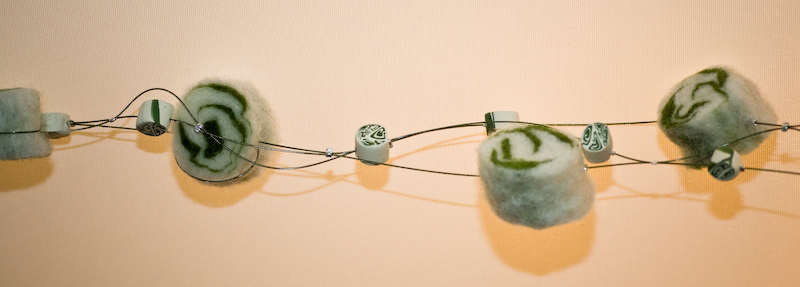For long winter evenings…knitted bracelet and the neclase
Wednesday, March 11th, 2009Take knitting to the next level, try with wire and simple silver beads – ideal for long evenings in front of the TV
Take knitting to the next level, try with wire and simple silver beads – ideal for long evenings in front of the TV
In previous posts you a had chance to see polymer clay beads and felt ones. Today I put both together and created this mixed media “chain”.

As a continuity for bead making, mixing different media and techniques I used single crochet stitch around a wooden bead. It is a simple task, just follow the instructions below:
SC – single stitch
CH- chain
HK- Hook
Dec – decrease
CH of 2
1. 3SC in 2nd CH from the HK
2. 2 SC in each SC (6SC)
3. 2 SC in each SC (12 SC)
4-6. 1SC in each (12)
7. 1SC dec over next 2SC (6SC)
8. 1SC dec over next 2SC (3SC)
Enjoy!!!
As I promised today I am posting an example how to combine polymer clay with felt beads mimicking look of clay ones. As beads on wire they are great example of mixing media and techniques giving us contemporary look.
Today I got inspired on Granville Island and decided to play with polymer clay using millefiori technique to make beads. In the next post I am going to combine these beads with felt beads which are mimicking poly once. Below are some interesting info about Polymer Clay.
cyt: Wikipedia
Millefiori is a glasswork technique which produces distinctive decorative patterns on glassware. The term millefiori is a combination of the Italian words “mille” (thousand) and “fiori” (flowers). A. Pellatt (in his book “Curiosities of Glass Making”) was the first to use the term “millefiori”, which appeared in the Oxford Dictionary in 1849. The beads were called mosaic beads before that time. While the use of this technique long precedes the term millefiori, it is now frequently associated with Venetian glassware.
Bakelite, an early plasticused in both practical and decorative applications, was extremely popular with designers and had an early form of polymer clay available in kits, but the phenol base of uncured Bakelite was flammable and these were discontinued. Modern polymer clays are based on a plastic modeling compound brought to the attention of German doll maker Kathe Kruse in the late 1930s as a possible replacement for plastics that had become difficult to obtain during the early days of World War II. It was not suitable for use in her doll factory, so Kruse turned it over to her daughter Maureen, who was known in the family as “Fifi”. The formulation was later sold to Eberhardt Faber and marketed under the name FIMO (FIfi’s MOdeling Compound) in honor of Maureen.
Finally managed to upload some pictures on Flickr and used they slide show convenient tool. You are more than welcome to check link under SOIGNE ATELIE. I captured a screen shots from Flickr and got this cool mini kind of mix media jewelry collage.
I am currently teaching basics of mix media jewelery. Within 4 hours you will make 2 -3 pendants using soldering iron, glass, photographs and lead free solder. During the class we will cover different methods of aging the metal to “antique” the look. You will be provided with detailed handouts and all the information to start your little home pendant production. More details and pictures of the pendants in the next post.
Lately I spend lots of hours mastering my felt skills. Using wool, felt needles, soap, hot water and the bubble wrap you can make amazing items with no strength and little time. Soon Soigne will offer two evenings course covering dry and wet felting techniques.
Soigne was born out of the passion of experimenting with metal, clay, wood, glass, cement, resin and found objects. It all begun in my home kitchen and slowly got extended to me and my partner Nik’s art studio where we spend most of our free time. Welcome to the blog and enjoy my updates.
coming soon: